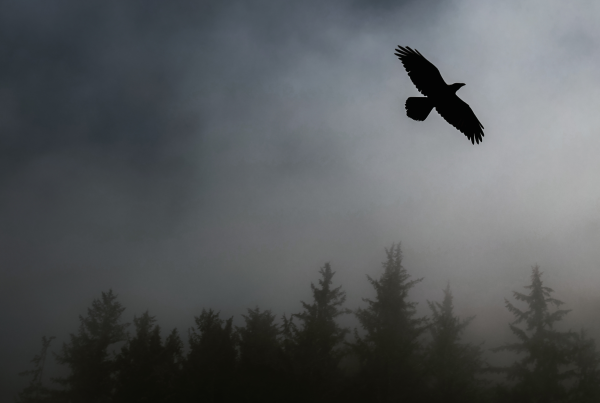Around the world, Indigenous Peoples share a very similar respect and caretaking relationship with the land. Those stewardship values stretch back through time immemorial and exist as living, breathing ‘laws of the land’ today. It’s incredibly exciting to see the braiding of modern rights-based laws with Indigenous legal frameworks in courtrooms everywhere.
This Earth Day, we want to celebrate the Indigenous laws that continue to exist, interact with, and — often — resist colonial structures. These Indigenous legal systems are thousands of years old and arise from traditions, language, and practices that not only grounded human culture in sustainability for countless generations, but also hold great promise to shape our common future.
Ǧviḷ̓ás – Heiltsuk
Ǧviḷ̓ás are Heiltsuk ancestral laws that serve as the guiding principle for all resource use and environmental management. Ǧviḷ̓ás is a complex and comprehensive system of laws that embodies values, beliefs, teachings, principles, practices, and consequences. Inherent in this is the understanding that all things are connected and that the role of every person is to maintain unity and balance.
Ǧviḷ̓ás has been described as the ethos of the Heiltsuk people. It can be summarized as “take a little and leave a lot”. This translates into sharing resources to support family and community, obligations to care for the lands and waters, and seeing all aspects of harvesting — from the taking of the resources to the methods used —as a gift of the Creator.
Heiltsuk’s legal challenge, which RAVEN supports, and which seeks to establish Aboriginal Title to the foreshore and seabed in the area where the fateful Nathan E. Stewart oil spill occurred, is grounded in Ǧviḷ̓ás. To prove title, the Nation must show use of, and jurisdiction over, the claim area dating back to before colonial contact. Evidence being gathered for the case shows how each Heiltsuk family holds responsibility over specific land and water bases, and how sustainable use is enforced by certain practices and teachings. While the case offers a way to recover from the devastation caused by an oil spill, it is groundbreaking as it seeks to enshrine the stewardship practices encapsulated by Heiltsuk Ǧviḷ̓ás into Canadian law.
Source: Heiltsuk Tribal Council http://www.heiltsuknation.ca/about-2/heiltsuk-culture/
Kweseltken – Secwepmec
In Secwépemc, Kweselten means “All My Relations.”
Secwepemc’s title case – supported by RAVEN – is about pre-existing Secwepemc title before contact. As with all First Nations, Secwepemc had a governing system before contact and still does. Their laws are based on the concept of “Kweseltkten” which is fundamental to everyday life, caretaker processes, and spiritual practices.
Part of Secwepmec’s strategy with the title case is to begin implementing Indigenous laws and jurisdiction over the lands and resources even before the court decision, to demonstrate to the court how Secwepemc governance co-exists with Canada and B.C. legislation.
Says litigation coordinator Robert Simon, “In the past our Secwepemc ancestors didn’t have really complicated laws for each and every resource or society behavior. They needed a concept that could be easily taught and upheld to all so everyone knew what the basic rule was and what the penalty was for not following that law.
“When you learn that you must use the concept of Kweseltkten for all actions, it becomes easy to figure out how to behave. You treat a tree as relative, and the forest, the water, the deer, salmon, berry bush… all as relatives…. And everything works out.”
The use of Kweseltkten is what helped Secwepemc Nation survive and thrive for over 12,000 years. Says Simon, “When the settlers arrived they found a rich and pristine paradise. They wrongly thought Secwepemc were savages who did not use any of the valuable resources like forests, water, land, salmon, deer, beaver…. Actually, we had managed all the resources following Kweseltkten laws! That is why everything was so pristine and plentiful.”
Source: Stk’emlupsemc Te Secwepemc Nation Litigation Coordinator Robert Simon
Ngo Dwe Waangizid – Anishinaabe
In English, Ngo Dwe Waangizid Anishinaabe translates to One Anishinaabe Family.
While their laws are ancient, in 2012 the Anishinabek Nation proclaimed the Anishinaabe Chi-Naaknigewin, the Anishinabek Nation constitution. Founded on Ngo Dwe Waangizid Anishinaabe, The Anishinaabe Chi-Naaknigewin forms the Traditional Government of the Anishinabek Nation and sets a solid foundation for governance and the exercise of inherent rights bestowed by the Creator.
The Anishinabek constitution is guided by the principles and way of life of the seven Grandfather teachings given to Anishinaabe, namely: Zaagidwin (Love), Debwewin (Truth), Mnaadendamowin (Respect), Nbwaakaawin (Wisdom), Dbaadendiziwin (Humility), Gwekwaadziwin (Honesty) and Aakedhewin (Bravery).
The adoption of the Anishinaabe Chi-Naaknigewin marks a return to Anishinaabe identity and traditional governance. It sets out the structure of the Anishinabek Nation Government with the power to develop laws and policies for the Nation.
With such a clear legislative and policy framework, it’s shocking that the Ontario government has failed to meaningfully consult Anishinaabe Nations in the Ring of Fire mining area. As the only people who have ever lived in the “Breathing Lands” of the James Bay lowlands, the relationships-based legal frameworks that have been established by Indigenous Peoples should be a guiding force in determining how the region should be stewarded.
When Indigenous legal frameworks, grounded in values of respect, humility and wisdom, are respected, everyone benefits.
Source: Anishinaabe Nation Constitution: http://www.anishinabek.ca/wp-content/uploads/2016/05/Anishinaabe-Chi-Naaknigewin-modified.pdf
Naut’sa mawt – Hul’qumi’num
Naut’sa mawt means “working together as one” in the Hul’qumi’num language shared by numerous Nations in the Salish Sea.
Living by the legal principle of Naut’sa mawt means moving through the world with mutual respect, and building trusting relationships based on open and honest communication, transparency, sharing, and inclusiveness. By keeping an eye on the common good shared by humans and non-human relatives, abiding by Naut’sa mawt is key to developing a vision for a sustainable future.
Many generations have lived and thrived in the Salish Sea, thanks to abundant resources that have been carefully stewarded for thousands of years by Indigenous Peoples. According to Tsleil-Waututh Nation, “We have a sacred trust, a responsibility to care for and restore our traditional territory to its former state. Our stewardship of the land, air, and water is deeply ingrained in our culture because we understand the health of our people is interconnected with the environment we inhabit.”
That vision is reflected in every action and every decision Indigenous Nations make. Opposing the Trans Mountain (TMX) pipeline project continues to be a commitment that is part of a legal tradition aimed at sustaining and strengthening Indigenous culture. RAVEN was deeply honoured to work with Tsleil-Waututh and Squamish Nations in their legal challenges to the TMX oil sands pipeline and tankers project.
Source: Tsleil Waututh Sacred Trust Initiative
Dechen ts’edilhtan – Tsilhqot’in
The literal translation of deche ts’edilhtan is “laying down the stick”: in English, simply known as ‘law’.
Tŝilhqot’in Nations have occupied ancestral lands since time immemorial. Thanks to inherent rights, bestowed by the Creator and affirmed in the Supreme Court of Canada, Tŝilhqot’in hold and maintain Indigenous rights and title to their lands and waters.
Having never surrendered or abandoned their rights, Tŝilhqot’in identity is fundamentally connected and cannot be separated from the lands and waters of their territory.
On June 26, 2014, the Supreme Court of Canada declared Aboriginal title for the first time in Canadian history, in the homeland of the Tŝilhqot’in people, within the caretaker area of Xeni Gwet’in First Nations Government – one of six communities that comprise the Tŝilhqot’in Nation.
Xeni Gwet’in First Nations Government enacted its first modern written law, the Nemiah Declaration; the law was affirmed by Xeni Gwet’in and the Tŝilhqot’in Nation in 2015, and contributed to the arguments made in a RAVEN-supported court challenge to push back against Taseko Mines’ attempts to turn sacred Teztan Biny (Fish Lake) into an open pit gold/copper mine.
Since then, laws relating to hunting — The Nulh Ghah Dechen Ts’edilhtan law — and to water protection — Elhdaqox Dechen Ts’edilhtan (Sturgeon River Law) — have been passed by Tŝilhqot’in Nations to enforce stewardship principles on Indigenous and non-Indigenous peoples alike in the territory.
Source: Tŝilhqot’in National Government
Ayookw: Gitxsan
Ayookw is a Gitxsan concept that means, simply, a way of being and living in a good way. Ayookw is acknowledged and passed down from Gitxsan ancestors and is guided by language, laws, and traditions.
According to legal scholar Val Napoleon, Ayookw is “an active, robust, complex, and public legal system that took place, as it has for thousands of years, in the feast house. Feasts are highly regulated in form: conventions govern matters such as where each clan will sit in relation to each other, the order in which speaking is to be done, the processes associated with the transfer of ownership of land resulting from the death of a chief, the nature of burials, and the places in one’s territory where food is gathered to be served at the feast. This is not a chaotic or lawless place… No, this is a place of law, a parliament or legislature: a public venue for the assertion of law and a legal order that governs everything from marriage to trespass, and from access to territory and the ending of interpersonal conflicts.”
Gitksan’s legal traditions have enabled them to effectively manage themselves in a complex society. Gitksan legal traditions have been drawn on within the colonial court system, first in the historic Delgamuukw challenge and later as part of an effort to stop a Petronas LNG pipeline in northern B.C.Ayookw continues to be the basis for Gitxsan people’s enduring connections to their territories. Today, the Nation is pushing the Crown to see the possibility of reconciliation with the Gitxsan based on the foundation of their Ayook, language, culture, lands and resources. The laws that guide the Gitxsan people have a solid foundation of fairness, honour, respect, truth, openness, inclusiveness, accountability, and responsibility.
Source: Ayook: Gitxsan order, law and legal theory, Val Napoleon.
A framework to move forward, together
We live at a time of climate crisis where conflict over fossil fuel resources threatens to overturn decades of progress towards human rights and intercultural cooperation. At the same time, we live in an era when new life is being breathed into ancient legal orders, rekindling and illuminating the profound stewardship practices of Indigenous Peoples. Learning from those ways of knowing and being offers a way forward through the huge challenges we collectively face.
The principles of reciprocal relationship with all living things at the heart of Indigenous legal frameworks can offer humanity a way to survive – and thrive – after centuries of colonial misdeeds.














